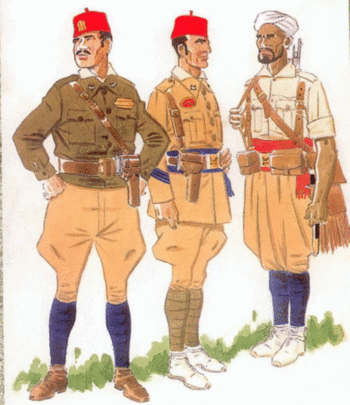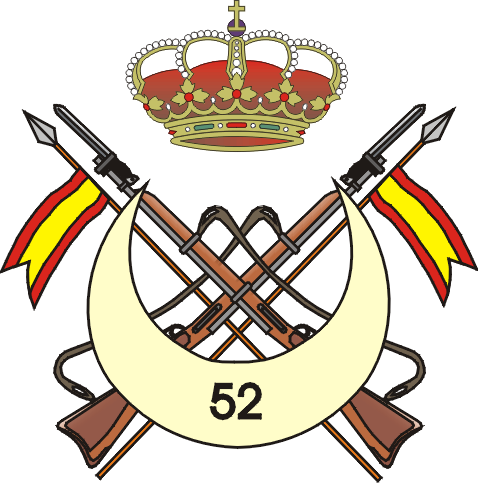Active 1911 - present Allegiance King, Fatherland | Country Spain Branch Army Role Vanguard troops | |
 | ||
Motto Fiel Regular hasta morir (Faithful Regular till death) Similar | ||
M s de un siglo de vida de las fuerzas regulares
The Fuerzas Regulares Indígenas ("Indigenous Regular Forces"), known simply as the Regulares (Regulars), were the volunteer Infantry and cavalry units of the Spanish Army recruited in Spanish Morocco. They consisted of Moroccans officered by Spaniards. These Moroccan troops played a significant role in the Spanish Civil War (1936–39).
Contents
- M s de un siglo de vida de las fuerzas regulares
- Establishment
- Rif Wars
- Spanish Civil War
- Under the Franco regime
- Present day
- Uniforms
- Modern parade march
- Military Music Units
- Depiction in popular culture
- References

Establishment

The Regulares were first raised in 1911 as a "batallón indígena" of infantry. Their formation came at a time when the Spanish army was expanding into the Moroccan hinterland from the long held coastal enclaves of Ceuta and Melilla. Previously use had been made of Moroccan auxiliaries as scouts and the designation of "regulars" appears to have been intended to distinguish the newly raised force as a permanent unit of the Spanish army. Officers and some NCOs were seconded from Peninsular regiments. By 1914 four Groups (Grupos, the equivalent of a regiment) had been raised for active service. While the Regulares remained predominantly infantry, recognition of Moroccan skills as horsemen led to the establishment of cavalry squadrons. This mounted element of the Regulares was to remain a conspicuous feature throughout the period of Spanish rule of the protectorate. As such, each Group was composed of a headquarters and service company, two infantry Tabors (battalions) and a cavalry Tabor (squadron) plus a military band and Corps of drums attached to the regimental headquarters. From 1914 to 1922 the Regulares were expanded in numbers to five "Grupos" based respectively in Melilla, Tetuán, Ceuta, Alhucemas and Larache (the Alhucemas Group was raised in 1921).

The Regulares infantry were known for their ability to traverse "dead ground" without being detected, but their Spanish officers disliked unconventional warfare and only infrequently took advantage of this skill.
Rif Wars

The Moroccan troops generally remained loyal during the Rif War of the early 1920s, although there were reports of mutiny at Yat el Bax following the major Spanish defeat at the Battle of Annual (Spanish spelling) or Anwal (English spelling) in 1921. During this period the Regulares and the Spanish Legion ("Tercio") emerged as the elite corps of the Spanish Army - long-serving professionals on more or less continuous active service, attracting the best officers. These included the future dictator Francisco Franco who served initially with the Regulares (from 1913) before transferring to the newly raised Tercio (whose troops were mostly Spaniards) as second in command and commander of its 1st Battalion in 1920.
In 1923 a detachment of the Fuerzas Regulares de Ceuta mounted guard at the Royal Palace in Madrid, indicating the high-profile achieved by the Moroccan troops. 1923 was the year in which the reactionary General Miguel Primo de Rivera became dictator of Spain, ruling in the King's name. In 1934 cavalry and infantry of the Regulares were brought to Peninsular Spain by the Republican Government to assist in the suppression of the rising by Asturian miners that year.
Spanish Civil War
In 1936 the Spanish "Army of Africa" (totaling 30,000 in the Legion and Moroccan Regulares regiments) were made part of the rebellion led by General Franco against the Republican Government in Madrid. In the crucial initial phase of the Spanish Civil War, the rebels were able to airlift a great number of Moroccan troops plus legionnaires across the Straits of Gibraltar with German and Italian assistance, in order to become the shock troops of the Nationalist battles. The professionalism and brutality of the Army of Africa played a major part in early Nationalist successes. As the war continued five more grupos of Regulares infantry were raised plus two of cavalry (the 1st Cavalry Group based in Teutan and the 2nd Cavalry Group in Melilla).
The Regulares with their experience of North African warfare proved to be excellent combatants in the open countryside while advancing from Seville to Madrid during August - November 1936. However they subsequently proved less adapt at street fighting in unfamiliar urban environments. With the raising of substantial Nationalist forces in mainland Spain the role of the Regulares diminished but they retained a key function as shock troops until the end of the Civil War. Conspicuous in Franco's victory parade in Madrid in 1939, the Regulares were the most decorated units of the Nationalist forces. The numbers of the Army of Africa doubled in the course of the war to about 60,000.
Under the Franco regime
Following the Nationalist victory the Regulares were reduced in number but retained their structure. Franco authorized the establishment of a ceremonial mounted honour guard ("Guardia de Su Excelencia el Generalísimo") from the Regulares cavalry which, with colourful Moorish uniforms and white Arabian horses, served in close attendance on him and formed part of his guards unit.
With the independence of Morocco in 1956 the majority of the Moroccan personnel of the Regulares, numbering about 12,500, were transferred to the newly raised Royal Moroccan Armed Forces. The two cavalry units were disbanded and the Groups were reduced to just eight. In 1957 Franco's ceremonial guard in Madrid, the Guarda Mora (Moorish Guards), were replaced by an escort of Spanish cavalry who retained the white cloaks and horses of the Regulares.
Present day
Spain however retained the historic enclaves of Melilla and Ceuta and the reduced Groups of Tetuan, Melilla, Ceuta and Alhucemas remained in existence as part of the two garrisons. The modern Spanish Army retains two regiments of Regulares which still parade in the fezs, sashes and white cloaks of the traditional Moorish style dress uniforms, although now recruited solely from Spanish citizens, many of them natives of Ceuta and Melilla, both Muslim and Christian.
As part of a wider reorganisation of the Spanish Army in 1986, the existing 4 Regulares Groups were amalgamated into these two light infantry regiments:
both regiments also being the successors to the regular infantry regiments of the Spanish Army which served both cities.
In recent years detachments of Regulares have served in both Bosnia and Afghanistan.
Tabor is the name given to the Regulares' constituent battalions of infantry and squadrons of cavalry.
Uniforms
The Regulares have the same camouflage dress for active service and ordinary duties as the rest of the Spanish Army but retains the unique, khaki Tropical uniform for semi-formal barrack dress and as the basis of its parade uniform. Perhaps the most distinctive features of the modern Regulares uniform is the red fez, red or blue sashes and white cloaks (burnous) of their Moorish style dress uniforms.
Modern parade march
These regiments and their attached battalions march in both quick and slow time on parade and only turn to the slow march when they are ready to render salutes on the march.
Military Music Units
The military bands and Corps of drums of the Regulares regiments and Tabors are commonly known as the Nubas. They are the same as the normal Spanish Army military bands except that the Corps of Drums is a mix of drums, cymbals, tambourines, bugles, trumpets, bagpipes and African flutes. At the present time only the Corps of Drums is seen in continuous active service, with military band support usually from other units. It is led by a Bugle Major who in the past was the assistant of the drum major. On the 2014 National Day Parade the Corps of Drums of the 54th Regulares Group reinstated the practice of being led by a drum major.
Depiction in popular culture
The sentence Luchamos contra los moros in the Spanish Republican song Ay Carmela, as well as one of the verses of Si me quieres escribir refer to the Regulares.
The main character in the novel Kábila by Fernando González Martín is a Moroccan who as a teenager hates Spanish colonial troops, becomes later a soldier of the Regulares, has a major role in the Asturias repression, and ends as a high-rank commanding officer in Franco's army.
A famous "jota Navarra" sung from the civil war times till now refers to this military unit: "Tengo un hermano en el Tercio/ Y otro tengo en REGULARES/ y el hermano mas pequeño/ preso en Alcalá de Henares." You can hear it at any "jota" festival or contest because the song is a well known classic.
